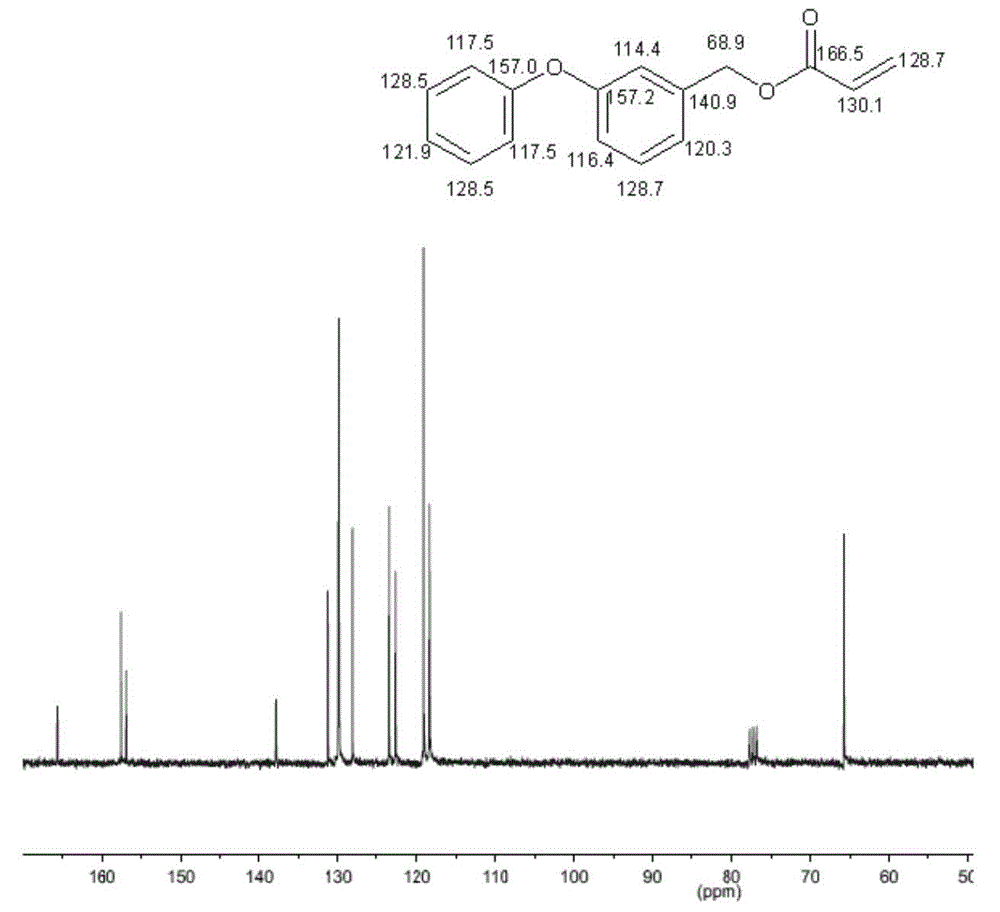Preparation method of phenoxy benzyl acrylic ester
A technology of phenoxybenzyl acrylate and acrylic acid, applied in the field of preparation of phenoxybenzyl acrylate, can solve the problems of limited effect, increase production cost and the like, and achieve cost saving, low chromaticity and low reaction temperature. Effect
- Summary
- Abstract
- Description
- Claims
- Application Information
AI Technical Summary
Problems solved by technology
Method used
Image
Examples
Embodiment 1
[0032] Add 10 grams of 3-phenoxybenzyl alcohol, 4.32 grams of acrylic acid, 30 grams of cyclohexane, 0.24 grams of methanesulfonic acid, and p-hydroxyl Anisole 0.072 gram, 50wt% hypophosphorous acid aqueous solution 0.286 gram, in the reaction process, lead nitrogen protection always, after reflux reaction at 80~85 ℃ for 5 hours, generate about 0.9 milliliters of water, continue to reflux for 2 hours, the water quantity is constant.
[0033] After the reaction, the reaction mixture was washed twice with 5% aqueous sodium hydroxide solution, then washed three times with distilled water, and finally dried with anhydrous magnesium sulfate, and then 0.02 p-hydroxyanisole, a polymerization inhibitor, was added to the dried solution. gram, at 50 DEG C, vacuum degree is under 0.1MPa condition, removes solvent cyclohexane with rotary evaporator, obtains colorless transparent product-phenoxybenzyl acrylate (11.56 grams, yield is 91%), gas chromatography The analyzer purity was 96.7% an...
Embodiment 2
[0035] Add 10 grams of 3-phenoxybenzyl alcohol, 4.32 grams of acrylic acid, 30 grams of cyclohexane, 0.24 grams of methanesulfonic acid, and p-hydroxyl 0.072 grams of anisole, 0.029 grams of 50wt% hypophosphorous acid aqueous solution, nitrogen protection always in the reaction process, after reflux reaction at 80~85 ℃ for 5 hours, generate about 0.9 milliliters of water, continue to reflux for 2 hours, the amount of water remains unchanged.
[0036] After the reaction, the reaction mixture was washed twice with 5% aqueous sodium hydroxide solution, then washed three times with distilled water, and finally dried with anhydrous magnesium sulfate, and then 0.02 p-hydroxyanisole, a polymerization inhibitor, was added to the dried solution. gram, at 50 DEG C, vacuum degree is under 0.1MPa condition, removes solvent cyclohexane with rotary evaporator, obtains colorless transparent product-phenoxybenzyl acrylate (11.94 grams, yield is 94%), gas chromatography The analyzer purity was...
Embodiment 3
[0038] Add 10 grams of 3-phenoxybenzyl alcohol, 4.32 grams of acrylic acid, 30 grams of cyclohexane, 0.24 grams of methanesulfonic acid, and p-hydroxyl Anisole 0.072 gram, 50wt% hypophosphorous acid aqueous solution 0.572 gram, nitrogen protection is always passed through in the reaction process, after reflux reaction at 80~85 ℃ for 5 hours, generate about 0.9 milliliters of water, continue to reflux 2 hours, the water quantity is constant.
[0039]After the reaction, the reaction mixture was washed twice with 5% aqueous sodium hydroxide solution, then washed three times with distilled water, and finally dried with anhydrous magnesium sulfate, and then 0.02 p-hydroxyanisole, a polymerization inhibitor, was added to the dried solution. gram, at 50 DEG C, vacuum degree is under 0.1MPa condition, removes solvent cyclohexane with rotary evaporator, obtains colorless transparent product-phenoxybenzyl acrylate (12.32 grams, yield is 97%), gas chromatography The analyzer purity was 9...
PUM
| Property | Measurement | Unit |
|---|---|---|
| Viscosity | aaaaa | aaaaa |
| Chroma | aaaaa | aaaaa |
| Chroma | aaaaa | aaaaa |
Abstract
Description
Claims
Application Information
 Login to View More
Login to View More - R&D
- Intellectual Property
- Life Sciences
- Materials
- Tech Scout
- Unparalleled Data Quality
- Higher Quality Content
- 60% Fewer Hallucinations
Browse by: Latest US Patents, China's latest patents, Technical Efficacy Thesaurus, Application Domain, Technology Topic, Popular Technical Reports.
© 2025 PatSnap. All rights reserved.Legal|Privacy policy|Modern Slavery Act Transparency Statement|Sitemap|About US| Contact US: help@patsnap.com


